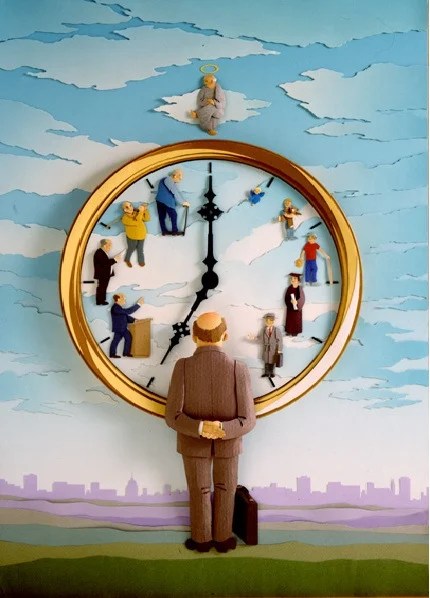
I begin from the paradigm that aging is not a random process but an adaptation, a programmed self-destruction.This was my entree into the field 27 years ago, and has been the theme of much of my research, including two books.For a summary of the evidence, heres ablog post from 2015, and heres the non-technical version ofmy book.Once you accept that the body is killing itself on a schedule, you have to ask how the schedule is maintained.
Just as growth is programmed in early life and then puberty is initiated by turning on sex hormones, aging happens when inflammation and auto-immunity and insulin resistance are gradually switched on when the body attains a certain age.This implies a master clock, probably the same clock that governs development also controls aging.Where is that clock and how does it work? If we had an answer to these questions, we could reset the aging clock and an 80-year-old body would act like a 30-year-old body, with all the robust repair and regenerative mechanisms fully engaged.The aging clock that we seek must have two conflicting properties.Of course, it must keep time reliably to trigger the phenotypes of growth, development, and then senescence on schedule.
It must also be homeostatic.Homeostasis is a fundamental property of life.All biological systems tend to restore their state when deranged by the environment.
If the clock is perturbed, it must be able to find its way back to a remembered biological age.Homeostasis is a defining feature of living organisms, perhaps the most fundamental property of life itself.The word refers to the capacity of a system to maintain its state in the face of slings and arrows of outrageous fortune.For example, we can swim in ice water or we can trek through the Sahara and our bodies maintain a core temperature pretty close to 98.6F.
We can drink Coca-Cola or we can fast for a week, and still the body keeps enough glucose in the blood to feed our cells without poisoning us with excessive blood sugar.We can take powerful proton pump inhibitors that jam with the bodys mechanism for creating stomach acid, but after a few months the body ramps up the acid factory as much as needed to digest our food.The point is that the body has many jobs that it needs to do, and it is exquisitely adapted to accomplish the most important of these no matter what are the outward circumstances.In the long run, the most important component of Darwinian fitness is the ability to keep on keeping on when the unexpected happens.
Homeostasis.But how can a clock be homeostatic? If the bodys clock is knocked far off the biologically-determined age, where is the reference information from which it can be reset?The existence of a clock is implied by the paradigm in which aging is an adaptive program.The need for homeostasis is a general property of biological systems.The only way that the two conditions can be met simultaneously is if there are several independent time-keeping mechanisms, and they are constantly exchanging information.
This condition derives from theoretical considerations.I concede that this is a dangerous way to draw conclusions about biology, which has always been primarily an experimental science.So I am going out on a limb to put forth this hypothesis:There ought to be several independent time-keeping mechanism in the bodies of complex organisms like the human animal, and there is continual cross-talk by which they are able to establish consensus, and reset the readout if one clock should differ substantially from the others.I havewritten in this columnabout a central clock in the neuroendocrine center of the brain, the suprachiasmatic nucleus, as documented (independently) by Claudia Cavadas (Lisbon) and Dongshen Cai (NYC).
Steve Horvath hasconvinced usthat there is a decentralized clock in the epigenetic state of dispersed cells around the body.Perhaps this counts as more than one clock, since Horvath has measured differences inaging rates in different organs.Epigenetic changes in stem cells may deserve the status of a separate clock.Telomere lengthin stem cells may constitute another clock.
Theimmune systemappears to have its own aging schedule, which was the subject ofRoy Walfords first theory of aging.Perhapsoxidative statusof the dispersed mitochondria constitutes a fifth clock.A new possibility is raised by the research fromMichael Levins Tufts University laboratory.
Levin has demonstrated a role for electrical patterns in morphogenesis, healing, and regeneration.His model for cancer is not genetic; rather he has demonstrate that he can create tumors from normal genomes by disrupting their electrical connection to one another, and he can cure cancer in highly-mutated tumors without killing the cells, merelyby restoring the cells electrical connectivity.Levin has speculated that electrical patterning is lost with age because many vertebrates are able to regenerate limbs or parts of limbs early in life, and gradually lose this capacity as they mature.We should not be surprised to discover other, independent timekeepers as well.
After all, the body must be coerced into killing itself, despite robust Darwinian adaptations that support individual survival and fecundity.If there were an easy path to mutating aging out of existence, then natural selection operating on a short time frame would have found it (withdisastrous consequencesfor the species and the ecosystem).If my hypothesis is correct, then all these clocks are exchanging signals, cross-checking to establish a consensus age and resetting accordingly.How do the various clocks exchange information? The obvious place to look is signal molecules in the blood.
These may be hormones or other large proteins; they may be short peptides; they may be RNAs or ribozymes; they may be extracellular vesiclescontaining a package of coordinated signal molecules of various types.Age signaling may be accomplished with a combination of all the above.This reasoning leads to the inference that exchanging young blood plasma for old ought to be a robust anti-aging strategy.
Besides erythrocytes and leukocytes, the blood carries many thousands of different signals as dilute molecular species dissolved in plasma.Some of these, I suggest, constitute primary information about the age state of the body.This information must be capable of resetting all the bodys different aging clocks.Of course, the work has commenced nearly two decades ago.
Experiments in heterochronic parabiosis.Irina and Mike Conboy did thefirst experimentsin the modern era while they were graduate students at Stanford.Harold Katcher wrote up theory of why this work ought to be the portal to robust rejuvenation.The Conboys have gone on to promote a perspective in which old age is established affirmatively by molecular species in the blood of old animals.
In their model, diluting old blood with neutral saline albumen is a path to rejuvenation.In cooperation with Dobri Kiprov, they have initiated a human trial in rejuvenation based on blood dilution.Katcher and Tony Wyss-Coray and Amy Wagers have championed the converse perspective, that senescence is linked to a dearth of youthful signals in the blood of older animals.Katcher has doneproof-of-concept experimentsin rats.
Wyss-Coray has built acompanybased on injecting blood factors to treat Alzheimers Disease.The company, called Alkahest, has been acquired by the Spanish giant,Grifols, which has been a major player in plasmapheresis therapies.Dan Stickler has aclinic in Texasoffering blood plasma from young donors.
David Haase at theMaxwell Centerhas long experience offering plasmapheresis as a therapy.I think it likely that the most effective strategies for rejuvenation will involveboth removal of pro-aging factors and addition of anti-aging factorsto the blood plasma.Discovering what these factors are and how they work ought to be a major target for research in the field of medical gerontology.One easy place to start is with extracellular vesicles.
These are larger than molecules, smaller than cells, and they are normally filtered out in plasmapheresis.But they may play a crucial role in plasma exchange as an anti-aging strategy; it will be important to know.Reality checkHow well can we expect the new plasma transfusion therapies to work? We have some experience that should guide our expectations.Two summers ago, I was hit by a car while riding my bicycle and lost most of the blood in my body.Heroic surgery kept me from bleeding to death, against all odds.
I received blood during that first surgery and more blood was lost and replenished during 7 follow-up surgeries.Themedian age of blood donorsin America is about 47.I was 72.
Its possible that replacement of the majority of my blood with younger donors had a rejuvenating effect, but if there was any benefit at all, it was not dramatic enough to be noticeable to me or my family.5 million people a year receive blood transfusions.Some of them are very old, and none of them has skipped out of the transfusion clinic with youthful hair color and de-wrinkled foreheads.A history of blood donation year after year has a substantialbenefit for life extension, but it is not dramatic.Giving a pint of blood is equivalent to a 10% dilution, and habitual donors do this a few times per year.
(I was donating blood several times a year before my 2021 hospitalization.) Based on standard life tables, 30% decrease in mortalityis equivalent to about 3 years of added life.From this, I would expect that my proposed homeostatic age-resetting mechanism works slowly.We dont know specifically the lifetime of aging signals in the blood because we dont know what these signals are; butstudies of generic protein turnoverin blood plasma suggest ten days or so as a reasonable guess.In Katchers rats, the figure iscloser to 2 days.From this, we can say it is likely that resetting the rats biological clock takes at least several times 2 days, and resetting the human clock requires at least several times 10 days.
It may require repeated transfusions every 10 days over a period of months to see the full effect.Concerning the effectiveness of E5 in Katchers rats, we are still learning.The biomarkers, including Horvath age, were very promising.Longevity seemed to be increased only modestly, however except forSima, the last remaining rat (out of 8) who has now broken records for rat longevity at 46 months.
Harolds reported rejuvenation of skin on one hand based on a single application of E5 is an intriguing anecdote that encourages us to hope for the best.Im going to pose a much more speculative argument that rejuvenation through transfusions of young blood will be effective, but will not change paradigms about human lifespan.I conjecture that therichest and most powerful peoplein the world have special access to technologies that are unavailable to you and me.Have some of them been getting blood transfusions from young donors? David Rockefeller died six years ago, just short of 102 years old.
Queen Elizabeth died at 96.Evelyin de Rothschild died last year at 91.Henry Kissingeris still alive at 99.Jimmy Carteris 98.George SorosandWarren Buffettare each 92 and they look it.The bottom lineI remain optimistic about Harold Katchers work and about plasma exchange in general, but we still have a lot of work to do.And by the wayThere are other ways to die, unrelated to age.Bioweapons research has spawned a worldwide epidemic, killing millions, and next time could be worse.
We live in a time when collective threats to our existence may soon become as great as the mortality burden imposed by age.Aging evolved for the purpose of stabilizing ecosystems.Human beings have shown themselves to be adept at destabilizing ecosystems, and now we want to further expand our numbers and extend our power of nature.Mankind cannot transcend nature.
Humans cannot live outside the context of Gaias ecosystem.If we try, it will be the extinction not of Gaia but of the human race.I believe that the pursuit of longevity is not only scientifically feasible but also worthwhile.But this grand project must be pursued in tandem with an even grander project, which is to change our relationship to naturally ecology from a miner and exploiter to a cooperative steward.There is evidence that the native population of America had such an ethos, together with the wisdom and the science to create richer ecosystems for their own sake and for the sake of natures abundance and diversity.
It is required of humanity that we quickly learn that lost art, on pain of extinction.
Publisher: Josh Mitteldorf ( Read More )

